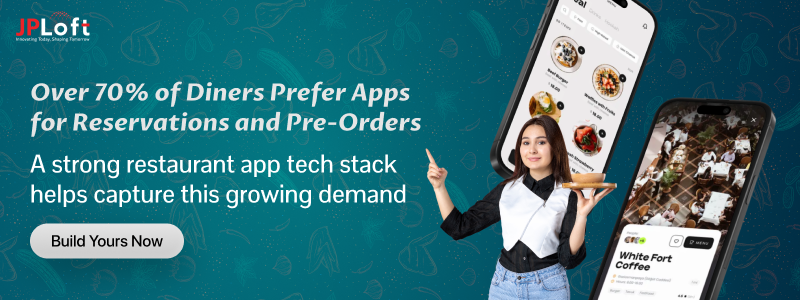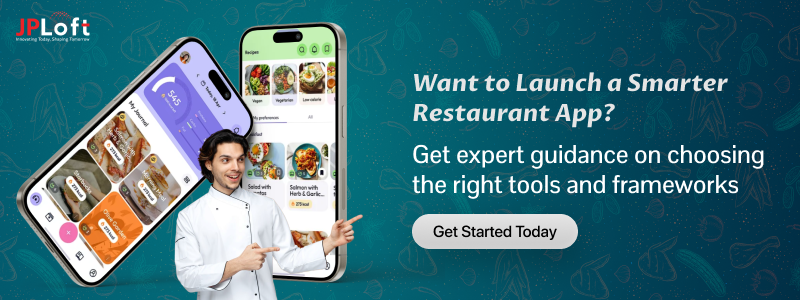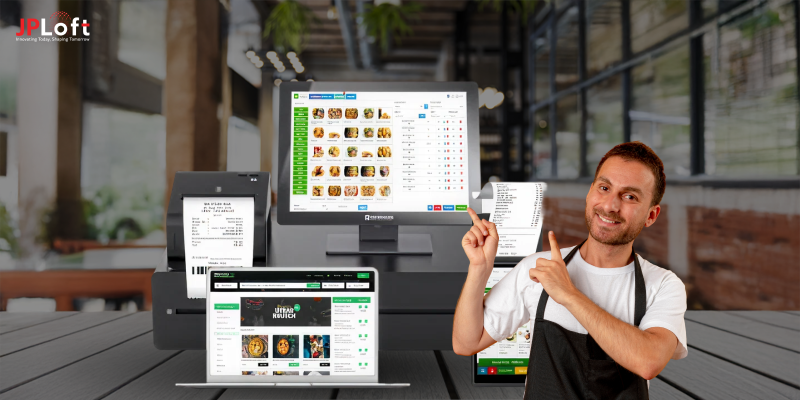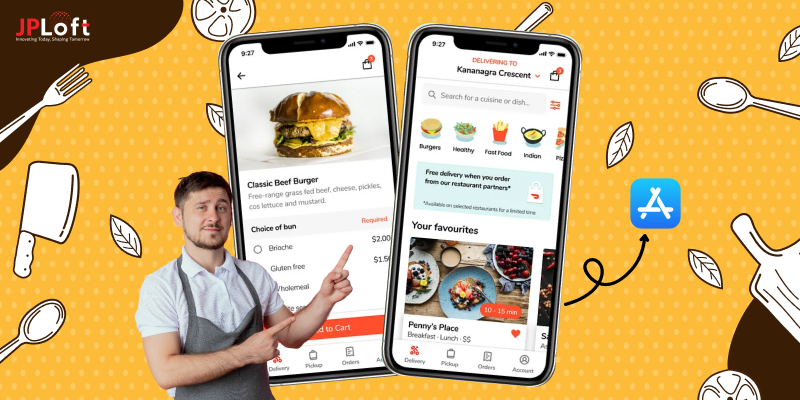Key Takeaways
A well-planned restaurant app tech stack is the backbone of any successful restaurant app, ensuring smooth performance, scalability, and an excellent user experience.
Understanding both the restaurant app frontend stack and restaurant app backend stack, mobile frameworks, and database solutions is crucial for creating a reliable and efficient app.
Selecting an Ideal restaurant app tech stack involves analyzing your app’s objectives, required features, scalability, security, and integration needs before finalizing technologies.
Regular updates, testing, and maintenance are essential to keep your app secure, compatible, and aligned with industry trends.
Partnering with experts like JPLoft ensures your restaurant app is built on the right tech stack for restaurant apps, optimized for performance, and supported with long-term guidance.
In today’s fast-paced food industry, restaurant apps are no longer optional; they’re essential for driving convenience, efficiency, and customer loyalty.
However, what makes these apps truly successful is the restaurant app tech stack powering them.
The right combination of technologies ensures smooth operations, real-time updates, secure payments, and a seamless user experience.
Whether you’re developing a simple ordering app or a complex multi-restaurant platform, understanding how to build a restaurant app tech stack on the right foundation is key.
This blog serves as a guide to restaurant app tech stack, helping you explore the components, selection process, and best practices to ensure your app is efficient, scalable, and future-ready.
Benefits of Choosing the Right Restaurant App Tech Stack
Selecting the right restaurant app tech stack is more than just a technical decision; it directly impacts your app’s performance, user experience, and business growth.
Here are four key benefits of choosing an Ideal restaurant app tech stack for your project:
1. Enhanced Performance and Speed
A well-planned tech stack ensures your app runs smoothly, even during peak traffic hours. From faster load times to seamless menu browsing, your users enjoy a consistent experience.
If you’re curious about how to develop a restaurant app, choosing technologies that optimize performance is the first step toward a reliable product.
2. Scalability for Future Growth
Your restaurant app may start small, but it should be ready to grow. An ideal restaurant app tech stack allows your platform to scale effortlessly, whether you’re adding new restaurants, integrating delivery partners, or introducing AI-driven features.
Considering the cost to develop a restaurant app, investing in a scalable stack now can save significant redevelopment expenses later.
3. Improved Security and Compliance
Restaurants handle sensitive customer data, from payment information to personal preferences.
The right tech stack supports robust security protocols, ensuring compliance with data protection standards. A secure app not only builds trust but also protects your business from potential liabilities.
4. Streamlined Maintenance and Updates
A carefully chosen tech stack for restaurant apps simplifies future updates, feature integrations, and bug fixes. With maintainable code and compatible frameworks, your app team can implement enhancements quickly, keeping your platform competitive and reliable in a constantly evolving market.
By understanding these benefits, restaurant owners and developers can make informed choices.
A strong tech foundation is not just a technical requirement; it's a strategic advantage that ensures long-term success.
Basics of Restaurant App Tech Stack
Building a successful restaurant app begins with understanding the basics of a restaurant app tech stack guide.
The tech stack is essentially the backbone of your app. It determines how fast it performs, how scalable it is, and how easily you can implement new features.
The mobile app tech stack for restaurant apps typically consists of three main layers: frontend, backend, and mobile frameworks, along with restaurant app database solutions and third-party integrations.
1] Frontend Basics
The restaurant app frontend stack is what users interact with directly. This includes the menus, reservation systems, ordering screens, and payment interfaces.
A clean, intuitive, and responsive frontend is crucial for user engagement. Many of the best restaurant apps leverage React Native or Flutter for a seamless cross-platform experience, allowing both iOS and Android users to enjoy smooth navigation and interactive elements.
2] Backend Essentials
The restaurant app backend stack powers the app’s core functions behind the scenes. This includes server management, APIs, user authentication, and data storage.
A robust backend ensures real-time order processing, inventory tracking, and secure payment handling.
Considering the cost to build a restaurant reservation app like OpenTable, developers must focus on a backend framework that is secure, scalable, and capable of supporting advanced integrations, ensuring long-term performance and efficiency.
3] Mobile Frameworks and Tools
The restaurant mobile app tech stack frameworks include the frameworks, SDKs, and libraries used to develop the mobile app.
Platforms like Flutter, React Native, or native Swift/Kotlin frameworks allow developers to create apps that are not only fast but also adaptable to future updates.
Keeping up with restaurant app development trends, such as AI-powered recommendations or voice ordering, often depends on selecting the right mobile frameworks at the start.
4] Additional Considerations
Beyond the core layers, your tech stack for restaurant apps should include restaurant app database solutions, cloud hosting, analytics tools, and third-party API integrations.
These elements enable features like predictive ordering, real-time delivery tracking, and personalized promotions.
The integration of AI in restaurant apps is becoming a standard trend, allowing apps to recommend dishes, optimize delivery routes, and even provide voice-activated ordering.
5] Why It Matters
Choosing the right tech stack isn’t just about functionality, it’s about creating a seamless, scalable, and secure experience that aligns with evolving user expectations.
When the underlying technology fails to support real-time ordering, personalization, or location-based services, the overall customer experience suffers leading to poor retention and lower revenue.
Understanding how to develop a restaurant finder app highlights the market value of using the right tech stack to deliver features like geolocation, smart recommendations, and instant availability that drive user adoption and revenue growth.
By understanding the fundamentals of frontend, backend, and mobile frameworks, along with emerging technologies, you can lay the foundation for a successful, future-proof restaurant app that stands out in a competitive market.
What Can Be Included in the Restaurant App Tech Stack?
Choosing the right restaurant app tech stack involves more than just selecting programming languages. It’s about combining tools, frameworks, and services that together power your app’s performance, scalability, and usability.
Whether you’re building a simple ordering system or an AI-driven restaurant ecosystem, understanding what goes into the stack can shape your app’s success from the start.
► Frontend Stack: The Face of Your App
The restaurant app frontend stack determines how your app looks and feels to customers. This includes technologies such as HTML, CSS, and JavaScript frameworks like React, Angular, or Vue.js.
A strong frontend focuses on intuitive design, seamless animations, and responsive interfaces that make ordering or reserving tables effortless.
Entrepreneurs exploring innovative restaurant app design approaches often experiment with frontends that emphasize personalization, aesthetics, and mobile responsiveness to attract modern, tech-savvy diners.
Additional frontend tools often include:
-
UI Libraries: Material UI, Bootstrap, Tailwind CSS
-
State Management: Redux, Vuex
-
Performance Tools: Webpack, Babel, Lighthouse
► Backend Stack: The Power Engine
Behind every fast and reliable restaurant app lies a robust restaurant app backend stack. This includes server-side languages such as Node.js, Python, or PHP, along with frameworks like Express, Django or Laravel.
The backend manages APIs, user authentication, and order processing while syncing real-time data between the restaurant, customers, and delivery partners.
For developers studying how restaurant apps make money, the backend also handles crucial business logic from payment integrations to loyalty program tracking and AI-driven personalization.
Additional backend technologies include:
-
API Frameworks: GraphQL, RESTful APIs
-
Web Servers: Nginx, Apache
-
Authentication: JWT, OAuth 2.0
-
Caching Systems: Redis, Memcached
► Frameworks and Development Tools
Modern restaurant mobile app tech stack frameworks like Flutter, React Native, and Kotlin Multiplatform streamline cross-platform development, enabling faster deployment on Android and iOS.
These frameworks help maintain consistency in design and performance while saving time and cost.
They are particularly valuable when entrepreneurs are learning how to start an online restaurant business, as they allow scalable builds without duplicating effort across platforms.
Additional development tools include:
-
IDE/Editors: Android Studio, Xcode, Visual Studio Code
-
Version Control: Git, GitHub, Bitbucket
-
CI/CD Tools: Jenkins, GitLab CI, CircleCI
► Database and Cloud Solutions
Data storage and management form the backbone of your app’s reliability. Restaurant app database solutions like PostgreSQL, MongoDB, or Firebase store everything from menu items and user profiles to order histories and payment details.
Cloud platforms like AWS, Azure, or Google Cloud ensure smooth scalability and high uptime, supporting data-driven decisions and analytics.
Optimizing database performance and ensuring seamless cloud integration are essential for maintaining speed, security, and consistent user experiences across all devices.
Additional technologies in this layer include:
-
Real-Time Databases: Firebase Realtime DB, Firestore
-
Cloud Storage: Amazon S3, Google Cloud Storage
-
Data Security: SSL/TLS encryption, AES-256
-
Load Balancers: AWS Elastic Load Balancer, Nginx
► Supporting APIs and Integrations
Beyond these layers, a complete restaurant app stack integrates third-party APIs for maps, payment gateways, AI analytics, and delivery management. These integrations elevate the user experience and add value-driven features.
Ignoring these essentials is one of the key reasons why restaurant apps fail, as limited integrations restrict app functionality and user engagement.
Common API integrations include:
-
Payment Gateways: Stripe, PayPal, Razorpay
-
Geolocation & Maps: Google Maps API, Mapbox
-
Push Notifications: Firebase Cloud Messaging, OneSignal
-
AI & Analytics: TensorFlow Lite, ChatGPT API, Google Analytics
► Additional Components: Security, Hosting, and DevOps
To ensure seamless deployment and long-term stability, modern restaurant apps also require secure hosting and DevOps practices.
Key technologies include:
-
Hosting Platforms: AWS EC2, DigitalOcean, Heroku
-
Containerization: Docker, Kubernetes
-
Monitoring Tools: New Relic, Datadog, Prometheus
-
Security Protocols: SSL certificates, role-based access control, firewalls
These ensure continuous uptime, fast deployment cycles, and protection of sensitive customer data.
Comprehensive Restaurant App Tech Stack Table:
|
Component |
Technologies / Tools |
Purpose |
|
Frontend (UI/UX) |
React, Angular, Vue.js, HTML5, CSS3, Tailwind |
User interface and experience |
|
Backend (Server-side) |
Node.js, Django, Laravel, Express.js |
Business logic and API management |
|
Mobile Frameworks |
Flutter, React Native, Kotlin Multiplatform |
Cross-platform mobile app development |
|
Database Solutions |
PostgreSQL, MongoDB, Firebase |
Data storage and retrieval |
|
Cloud Services |
AWS, Google Cloud, Microsoft Azure |
Hosting, scalability, and performance |
|
APIs & Integrations |
Google Maps, Stripe, ChatGPT API |
Payments, location, AI, and analytics |
|
DevOps & Deployment |
Docker, Kubernetes, Jenkins, GitHub Actions |
Continuous integration and delivery |
|
Security Tools |
SSL/TLS, OAuth 2.0, Firewalls |
Data protection and authentication |
In summary, every layer of the restaurant app tech ecosystem plays a distinct role, from the frontend that delights users to the backend and databases that ensure operational stability.
A well-structured stack allows your app to evolve, integrate new features, and stay competitive in an ever-changing digital dining landscape.
What is the Process to Select an Ideal Restaurant App Tech Stack?
Choosing the right technologies for your restaurant app isn’t just about picking what’s popular; it’s about aligning your app’s functionality, scalability, and business goals.
Understanding how to select an ideal restaurant app technology stack requires a strategic, step-by-step approach that ensures long-term efficiency and smooth performance.
Here’s a structured process to help you build an Ideal restaurant app tech stack that matches your unique business needs.
Step 1: Define Your App’s Core Objectives
The first step in selecting an Ideal restaurant app tech stack is understanding your app’s purpose.
Are you building an online ordering platform, a table reservation app, or a restaurant management system? Each requires a unique combination of frontend, backend, and integration tools.
For instance, if your focus is on smart reservations and customer interaction, consider reviewing how to build an app like The Fork for inspiration.
Your goals should dictate your technology choices, not the other way around. This ensures every component in your stack directly supports your business model and user experience.
Step 2: Analyze Functional Requirements
Before finalizing your tech stack, list out the essential features your app must deliver: real-time ordering, AI-driven recommendations, push notifications, or secure payment integration.
Understanding these requirements helps identify technologies capable of handling such complexity.
This stage lays the groundwork for a functional and flexible architecture that ensures efficiency, scalability, and an excellent user experience.
Step 3: Choose the Right Frontend and Backend Technologies
The frontend defines user interaction, while the backend manages logic and data flow. Your Ideal restaurant app tech stack should balance visual appeal with processing power.
-
Frontend: Frameworks like React or Flutter provide responsive designs and fluid navigation.
-
Backend: Technologies like Node.js, Django, or Laravel handle data-heavy operations with efficiency.
The procedure to select a restaurant app tech stack should always involve analyzing how these components will integrate and scale together.
Think about your audience’s device preferences and internet speeds when deciding frameworks to ensure smooth, real-time interactions.
Step 4: Prioritize Scalability and Security
As your restaurant app grows, you’ll attract more users, transactions, and data. The process to select an effective restaurant app tech stack must factor in scalability from the start.
Use cloud-based solutions like AWS or Firebase to handle growing demand seamlessly.
Security is equally important to ensure encryption, secure authentication, and PCI-DSS compliance for payment data.
A scalable stack prevents performance issues, while strong security builds customer trust, both essential for your app’s long-term success.
Step 5: Test and Validate Your Tech Stack
Before full-scale development, test your chosen stack in controlled environments. Compatibility testing helps identify performance issues early.
Comprehensive restaurant app testing ensures that both your frontend and backend technologies work seamlessly across various loads and devices.
Testing also helps refine your app’s responsiveness, user experience, and speed, critical factors in maintaining user retention in a competitive market.
Step 6: Plan for Long-Term Maintenance and Optimization
Even after launch, your tech stack requires ongoing optimization. As user demands evolve, continuous maintenance ensures your app remains updated and efficient.
Consistent restaurant app maintenance helps you manage framework updates, server optimization, and feature rollouts without disrupting service.
Regular audits also ensure your stack stays compatible with new technologies and operating systems, saving costs on large-scale redevelopments.
Step 7: Integrate Emerging Technologies
Modern restaurant apps increasingly rely on technologies like AI, IoT, and NLP to enhance customer experience.
For instance, adding AI voice ordering in restaurant apps or predictive analytics tools can make your app more intuitive and data-driven.
Selecting an adaptable stack ensures seamless integration of these emerging trends over time.
Step 8: Prototype and Iterate
Once your stack is defined, build a prototype or MVP before scaling to a full app. This step allows real-world testing of app performance, design, and usability.
If you’re exploring how to build a restaurant booking app, start with minimal yet essential features to test user feedback.
Based on those insights, refine your technologies and optimize for scalability and cost-effectiveness.
All in all, the journey of selecting an Ideal restaurant app tech stack involves thoughtful evaluation at every stage, from defining goals and analyzing features to ensuring security, testing, and future-proofing.
Following a structured procedure to select a restaurant app tech stack ensures your restaurant app performs seamlessly, remains adaptable, and delivers a superior dining experience digitally.
When chosen carefully, your tech stack becomes the backbone that fuels innovation, user satisfaction, and business growth in the restaurant app ecosystem.
Connect with JPLoft, and Select the Suitable Restaurant App Tech Stack
Selecting the right technologies for your restaurant app can be overwhelming, but with expert guidance, the process becomes straightforward.
At JPLoft, we help businesses build a restaurant app tech stack tailored to their unique goals, ensuring every component, from frontend and backend frameworks to restaurant app database solutions, is optimized for performance and scalability.
Our team follows a proven methodology, combining insights from a guide to restaurant app tech stack and hands-on experience to create an Ideal restaurant app tech stack for your project.
With JPLoft as your restaurant app development company, you gain access to expert consultation, seamless implementation, and long-term support to ensure your app thrives in a competitive market.
Conclusion
A well-chosen ideal restaurant app tech stack is the foundation of a successful, scalable, and user-friendly app.
From frontend and backend frameworks to mobile development tools and database solutions, every component plays a critical role in delivering a seamless experience for both customers and restaurant operators.
By following a structured restaurant app technology stack guide, businesses can make informed decisions, minimize development challenges, and ensure their app remains adaptable to emerging trends.
Investing time in selecting the right stack not only boosts performance and security but also strengthens customer engagement and long-term growth. The right tech stack transforms your restaurant app from an idea into a reliable, competitive digital solution.
FAQs
A restaurant app tech stack refers to the combination of technologies, frameworks, and tools used to build and operate a restaurant app. It includes frontend and backend components, mobile frameworks, databases, and third-party integrations that ensure the app functions smoothly and scales efficiently.
Choosing the right stack impacts performance, security, and user experience. A carefully selected stack allows your app to handle real-time orders, integrate new features, and scale with your business growth, reducing long-term maintenance costs.
Start by defining your app’s objectives, understanding the required features, and evaluating frontend, backend, and mobile frameworks. Consider scalability, security, and integration options to ensure your app is future-proof and aligned with business goals.
Yes. The choice of programming languages, frameworks, and third-party services can significantly influence development time and costs. Opting for scalable, compatible technologies can reduce future redevelopment expenses.
Regular updates are essential to maintain security, performance, and compatibility with new devices or operating systems. Monitoring industry trends and user feedback helps determine when and how to optimize your stack effectively.













Share this blog